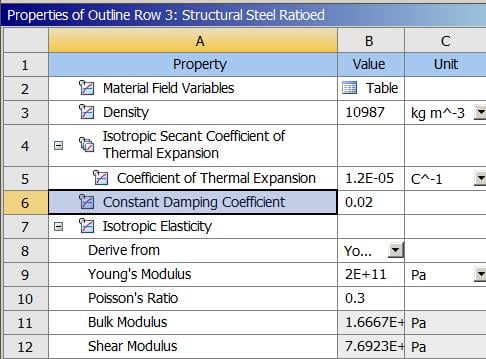-
-
April 30, 2019 at 11:54 am
Rifaat93
Subscriberhello People
"Material Constant Damping Ratio defined in Engineering Data is not contributing to modal damping calculations"
What does this mean ? and how can i avoid/stop it ? -
April 30, 2019 at 1:31 pm
peteroznewman
SubscriberThe default for a Modal analysis is the Undamped natural frequencies and mode shapes. If this is what you want, you can ignore this message.
What do you plan to do with the Modal results? If you are using them to perform a Modal Superposition Transient Structural analysis, you apply the damping in the Transient Structural model.
Did you specifically want the Damped natural frequencies? Is so, this is warning you that the Material Constant Damping Ratio defined in Engineering Data is not contributing to modal damping calculations. This means that if in Engineering Data you added Constant Damping Coefficient, it will not be used in the Damped Modal calculation.
If you want the Damped Natural Frequencies, you have to use the Damping Controls in the Modal Analysis Settings.
These controls accept the Rayleigh Damping coefficients to form the Damping Matrix as shown below.
Do you need more information on Rayleigh damping coefficients?
-
April 30, 2019 at 3:21 pm
Rifaat93
SubscriberI am trying to calculate the dissipated energy of a body that is dynamically compressed
When a body ( in my Project its a Concrete cylinder) is dynamically compressed then there will be internal friction and probably through this Friction , Energy will be dissipated
thats what i am trying to simulate
Can you help me with this? -
May 1, 2019 at 12:48 am
peteroznewman
Subscriber
-
- You must be logged in to reply to this topic.


- Basic questions about HPC license
- optiSLang: general question about output variables & expressions
- Keeping concentration same for different sized particles in discrete phase model
- 3-Way System Coupling (Thermal-Structural-Fluid)
- optiSLang & AEDT Optimetrics: response variable has value of 0
- Thermal Desktop: Running RadCAD and SINDA outside of AutoCAD

-
4683
-
1565
-
1386
-
1242
-
1021

© 2025 Copyright ANSYS, Inc. All rights reserved.












